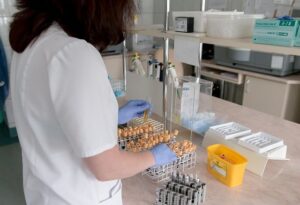What should be considered in the nonclinical safety evaluation of ADCs?
- What are the WHO recommendations for Japanese encephalitis vaccines?
- Individuals Carrying Two APOE4 Copies Likely to Develop Alzheimer’s Disease Symptoms
- What Is The Role of Lactic Acid in Tumor Growth and Therapy Resistance?
- The Enigma of Beethoven’s Deafness: Unveiling the Role of Lead Poisoning
- World First Autologous Regenerated Islet Transplantation Successful
- FDA Approved Opdualag: The First Immunotherapy Targeting LAG-3
What should be considered in the nonclinical safety evaluation of ADCs?
- AstraZeneca Admits for the First Time that its COVID Vaccine Has Blood Clot Side Effects
- Was COVID virus leaked from the Chinese WIV lab?
- HIV Cure Research: New Study Links Viral DNA Levels to Spontaneous Control
- FDA has mandated a top-level black box warning for all marketed CAR-T therapies
- Can people with high blood pressure eat peanuts?
- What is the difference between dopamine and dobutamine?
- How long can the patient live after heart stent surgery?
What should be considered in the nonclinical safety evaluation of ADCs?
Antibody-drug conjugates ( ADC) are composed of monoclonal antibodies targeting specific antigens and small molecule cytotoxic drugs linked by linkers, which have both the powerful killing effect of traditional small molecule chemotherapy and the tumor targeting of antibody drugs.
ADCs consist of three main components: antibodies responsible for selectively recognizing antigens on the surface of cancer cells, a drug payload responsible for killing cancer cells, and a linker that connects the antibody to the payload.
The first ADC ( Mylotarg ) was approved in 2000, and the number of approved ADCs has more than doubled since 2019, with a total of 5 ADCs approved in 2019-2020, and the ADC field continues to be hot.

Various strategies have been described for the nonclinical safety assessment of ADC drugs in oncology.
However, the complexity of ADCs necessitates that nonclinical safety evaluations be based on the specifics of the drug, while relying on the application of relevant guidelines and close consultation with regulatory agencies.
Key determinants of ADC toxicity include the choice of linker and conjugation technology and site in addition to targeted antigen selection and the mechanism of action of the payload.
The strategy for safety assessment should fully consider the available information for each component of the ADC. Many ADCs approved or in development for oncology indications use the same monoclonal antibodies or cytotoxic drugs, and a large amount of nonclinical and clinical data have been generated to fully exploit the advantages of these ADCs using the same linkers and small molecule toxic drugs Available information is very important. However, safety assessments should take into account not only available information for the individual components, but also possible differences in toxicity profiles, such as altered pharmacokinetics and tissue distribution-related differences, in combinations of specific ADCs. Conjugating toxic drugs to antibodies can alter the activity of either component or confer unique properties that can significantly impact safety, so the most clinically relevant toxicity data often come from studies of intact ADCs.
Correlation of experimental animal species
In order for nonclinical safety studies to adequately characterize ADC toxicity to support clinical development, it is critical to assess the relevance of animal test species and the availability of nonclinical results.
These typically require testing of ADC antibody affinity to target antigens in experimental animal species, and immunohistochemical staining to observe cross-reactivity.
In addition, species differences related to other components of the ADC, such as pharmacology related to small molecules or species differences related to linker stability, should also be considered. As with other drugs and biologics, comparisons of exposure parameters and metabolism should also be included.
BR-96 doxorubicin, a chimeric antibody targeting Lewis-Y antigen and an ADC drug conjugated with doxorubicin, in early non-clinical toxicology studies, it was found that dogs are different from rats and monkeys, and their toxic effects on ADC sensitive, and experienced hemorrhagic enteritis as a dose-limiting toxicity.
Studies have shown that BR96–DOX and the unconjugated antibody have the same dose-limiting toxicity, suggesting that the toxicity is mediated by the antibody, and gastrointestinal biopsy shows that the antibody binds to and damages epithelial cells, possibly due to complement activation .
Therefore, in the Phase I clinical trial of BR96 Dox in humans, dose selection was based on nonclinical observations in dogs, which, like humans, express the Ley antigen in gastrointestinal epithelial cells.
In a clinical study comparing the efficacy and safety of BR96-DOX and doxorubicin in breast cancer patients, the efficacy of ADC was lower, and there was a significant difference in toxicity between the two groups.
Administration of BR96-DOX was not associated with the typical side effects of doxorubicin, but did produce gastrointestinal toxicities, including nausea, vomiting, gastric ulcers, and bleeding, which were seen in nonclinical studies in dogs.
One patient who received BR96 mAb was reported to show gastrointestinal toxicity as well as patients who received the corresponding dose of ADC, consistent with toxicology data in dogs.
Gastrointestinal toxicity is thought to be a manifestation of the drug’s binding to normal tissues expressing the target antigen, which may impair delivery of the ADC to the tumor site.
Therefore, the development of drugs targeting Lewis antigens in cancer therapy should strive to reduce cross-reactivity with normal tissues.
The above case shows that identifying an appropriate test species is critical for predicting toxicity in humans, it helps to elucidate non-specific targeting of cytotoxic drugs through antibody conjugation, differences in toxicity profiles, and elucidation of toxicity drivers. , thereby guiding the clinical development of ADCs.
Expression of antibody target
As is the case with therapeutic monoclonal antibodies, the lack of antigenic targets in animal test species may hinder nonclinical evaluation of ADCs.
ICH S6(R1) Guidelines for the Preclinical Safety Evaluation of Biotechnology-Derived Drugs ( 2011 ) states that “species selection for antibody-drug/toxin conjugates ( ADCs ) containing novel toxins should follow the same guidelines as for unconjugated antibodies.
As a general principle…the relevant animal species used to test monoclonal antibodies are those that express the desired epitope and exhibit a tissue cross-reactivity profile similar to that of human tissue.” Thus, species and disease specificity may determine or limit nonclinical assessment.
Polatuzumab vedotin is an ADC targeting CD79b on human B cells, but preclinical studies found it did not bind CD79b in mouse, rat, or cynomolgus monkeys, resulting in a lack of pharmacologically relevant nonclinical species.
A nonclinical toxicity study was performed using a surrogate ADC that binds to cynomolgus CD79b, an alternative approach for the nonclinical safety assessment of biologics described in the ICH S6(R1) guideline, with an affinity for human CD79b similar to polatuzumab vedotin.
The surrogate ADC uses the same linker-payload as polatuzumab vedotin and has a similar drug-to-antibody ratio ( DAR ), but the surrogate antibody, unlike the clinical antibody, is a chimeric antibody with non-humanization.
Preclinical studies need to fully characterize the surrogate ADC ( including binding epitope, activity and potency, and PK ), and to provide relevant pharmacology, PK, and safety information for the corresponding polatuzumab vedotin.
Biological activity of drugs and/or antibodies
Although ADCs contain several components, in most cases, severe or dose-limiting toxicities observed in nonclinical and clinical studies of ADCs in oncology indications are primarily mediated by cytotoxic drugs and/or their metabolites .
For example, peripheral neuropathy occurs in many ADCs using microtubule inhibitors, most prominently MMAE. Additionally, ocular toxicity is often caused by ADCs containing DM4 and MMAF.
An FDA analysis of nonclinical safety data for all reported tumor ADCs found that ADC toxicity in rodents and cynomolgus monkeys was primarily seen in the hematopoietic system, liver, and reproductive organs.
If the payload, linker, DAR and dosing frequency are the same, the maximum tolerated doses ( MTDs ) in humans are similar regardless of antibody target or subtype.
This is consistent with the overlapping toxicity observed in preclinical studies of the four approved ADCs in rats and cynomolgus monkeys.

The toxicities observed in nonclinical studies of these ADCs are generally consistent with the expected activity of MMAE or MMAF.
The skin and ocular toxicity observed in nonclinical and clinical studies of enfortumab vedotin are thought to be mediated by targeting of Nectin-4, additionally, the ocular toxicity of belantamab-mafodotin is consistent with other MMAF-conjugated ADCs, and the associated inflammation caused by MMAF The reaction may be responsible for the toxic effects on the animal’s eyes.
Furthermore, cytotoxic-related toxicity was more pronounced in the rat assay without species cross-reactivity than in the monkey assay with cross-reactivity, suggesting that highly expressed targets may delay the onset of drug-related toxicity.
A recent FDA analysis of pyrrole-containing benzodiazepines ( PBDs ) with a DAR of 2 ADC data found that the toxicity exhibited by animals and humans was mainly caused by toxin drugs, not through antibody target-mediated effects. Obviously, consistent with the previous conclusions.
The mechanism of ADC off-target-related toxicity is currently unclear, but in addition to linker-payload instability leading to premature release, antigen-independent uptake of intact ADCs may also be caused by Fc-mediated and nonspecific endocytosis.
In a study of ADC-related ocular toxicity, a series of ADCs targeting ENPP3 containing mc-MMAF or vc-MMAE were evaluated. The findings found that micropinocytosis plays an important role in the internalization of ADCs by human corneal epithelial cells ( HCECs ), a process that depends at least in part on the biophysical properties ( charge and hydrophobicity ) of the ADCs.
Interestingly, the mAb conjugated to vc-MMAE ( AGS-16C3E ) and the mAb conjugated to mc-MMAF ( AGS-16C3F ) had similar cytotoxicity in HCECs, suggesting that the effect in the test is similar to this The two connector-payload types are irrelevant.
Toxicological studies of another ADC, an anti-RET mAb ( Y078 ) conjugated to DM1, emphasized the importance of all ADC components.
Y078 binds to RET in humans and cynomolgus monkeys with similar affinity, and tissue cross-reactivity also shows similar staining patterns, suggesting that monkeys are a suitable test species to assess targeting effects.
Toxicity studies found that Y078-DM1 and unconjugated Y078 were associated to a lesser extent with dose-dependent peripheral neuropathy.
Since RET is expressed in the adult peripheral nervous system, this is an expected consequence of targeting RET-expressing cells with potent microtubule-interfering drugs. However, neurotoxicity was also observed in unconjugated Y078 suggesting that the antibody has a role in addition to targeted drug delivery.
MEDI-547, an ADC conjugated to MMAF by an antibody targeting EphA2, the antibody moiety has similar affinity to human, cynomolgus monkey, mouse and rat EphA2.
However, although the coagulation abnormalities in patients reported in the phase 1 study were similar to those found in all three species in nonclinical studies, the doses at which severe hematologic toxicity occurred in humans were well below the safe doses predicted based on nonclinical studies, resulting in Clinical study discontinued. Based on the pharmacokinetic data, the ADC payload showed little detachment, so the antibody may be responsible for the toxicity observed in the study.
linker chemistry
Linkers are an important determinant of the safety and efficacy of ADCs. Linkers are generally classified into cleavable and non-cleavable types, and are designed to remain stable in the bloodstream while allowing the efficient release of small-molecule cytotoxins after endocytosis by target cells.
Linker stability in the systemic circulation has been a key focus of safety assessments, as premature loss of small molecules prior to internalization of ADCs in target cells may lead to off-target toxicity with nonspecific drug release.
The development of unconjugated mAbs with more stable linkers and maintaining lower levels is considered to be the key to improving ADC pharmacokinetic properties, therapeutic indicators and safety.
A big problem with Mylotarg is the insufficiently stable linker, but through optimization, subsequent ADCs such as inotuzumab ozogamicin and milatuzumab doxorubicin use similar acid-labile hydrazone linkers and show good stability in human plasma and serum.
However, comparison of ADCs containing hydrazone linkers with ADCs using protease-sensitive dipeptide linkers showed that peptide-linked ADCs were more stable in buffer and plasma than the corresponding hydrazone linkers and thus exhibited more specific delivery and lower systemic toxicity.
Species differences in linker-payload stability make it difficult to assess the therapeutic index of ADCs on the basis of nonclinical studies.
The enzymatic VC-PABC cleavage observed in mice contrasts with the stability detected in rat and cynomolgus monkey plasma, a difference attributed to species differences in carboxylesterase activity and substrate specificity .
Linkers also affect ADC physicochemical properties, such as aggregation tendency, which can affect ADC efficacy, hepatotoxicity, and immunogenicity.
During the development of ADCs using camptothecin cytotoxins, when comparing glucuronic acid-based linkers with dipeptide linkers, the more hydrophilic glucuronic acid linkers yielded more Less antibody aggregation.
The study also reported that the anti-Lewis-Y antigen dipeptide linker camptothecin ADC had no effect on tumor growth in a mouse model, whereas the corresponding glucuronide linker ADC induced substantial tumor growth delay.
Summary
The goal of nonclinical toxicology studies is to predict potential safety risks in the clinic.
The predictive value of non-clinical safety studies of ADCs can be enhanced by appropriate selection of animal species, understanding the mechanisms of adverse effects, or the drivers of ADC toxicity.
Nonclinical and clinical toxicity results reported during the clinical development of ADCs for oncology indications suggest that each component of the ADC may play a role in the observed toxicities and, therefore, should be considered when designing and interpreting nonclinical safety studies.
Although severe or dose-limiting toxicities appear to be primarily mediated by small molecules in most cases, different patterns are likely to emerge as the ADC field develops and expands.
References:
1. Considerations for the Nonclinical Safety Evaluation of Antibody–Drug Conjugates. Antibodies (Basel). 2021Jun; 10(2): 15.
What should be considered in the nonclinical safety evaluation of ADCs?
(source:internet, reference only)
Disclaimer of medicaltrend.org
Important Note: The information provided is for informational purposes only and should not be considered as medical advice.



